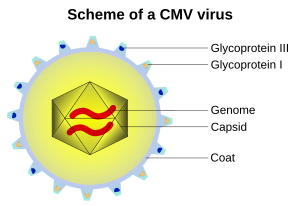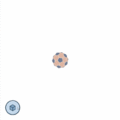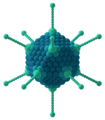Capsid facts for kids

Imagine a tiny, tiny package that holds a virus's most important secret. That package is called a capsid. It's like a strong, protective shell made of proteins. These protein building blocks are called 'capsomeres'. The capsid keeps the virus's nucleic acid (its instructions for making more viruses) safe inside.
Capsids come in different shapes. Some are like a sphere with 20 flat, triangular faces. This is called an icosahedral shape. Others are long and cylindrical, like a spiral. These are called helical capsids. Some viruses, like bacteriophages, have even more complex and unusual shapes. The faces of a capsid can be made from one or more types of proteins. For example, the virus that causes foot-and-mouth disease has a capsid with faces made of three different proteins.
Viral Envelopes: A Virus's Disguise
Many viruses, like the flu virus, have an extra layer covering their protein capsid. This layer is called a viral envelope. It's like a special coating made of lipids (fats).
Viruses get this envelope from the host cell they infect. They basically "steal" a piece of the host cell's inner nuclear membrane, Golgi membrane, or outer cell membrane.
This envelope can help viruses hide from the host's immune system. The envelope also has special Glycoproteins on its surface. These glycoproteins act like keys, helping the virus attach to and enter a new host cell. Once attached, the viral envelope can merge with the host cell's membrane. This allows the capsid and the virus's genetic material to get inside and start an infection.
Images for kids
See also
 In Spanish: Cápside para niños
In Spanish: Cápside para niños




